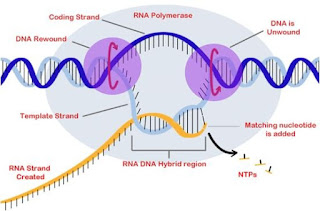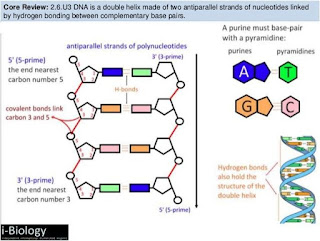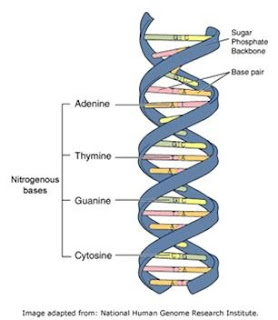DNA
Two different kinds of genetic material exist:
1.deoxyribonucleic acid (DNA)
2.ribonucleic acid (RNA).
• Most organisms use DNA for their long-term information storage. • Deoxyribonucleic acid (DNA) is a nucleic acid that contains the genetic instructions used in the development and functioning of all known living organisms and some viruses
During processing, DNA is transcribed, or copied into a special RNA, called mRNA.
•This mRNA is then transported out of the nucleus, where it is translated into a specific protein molecule.
• The biological information contained in an organism is encoded in its DNA sequence.
• RNA is also used for information transport (e.g., mRNA) and enzymatic functions (e.g., ribosomal RNA) in organisms that use DNA for the genetic code itself.
• Transfer RNA (tRNA) molecules are used to add specific amino acids during the process of protein translation.
• In humans the nuclear genome is divided into 23 pairs of linear DNA molecules called chromosomes.
• The structure of DNA is made up of three components namely base, sugar and phosphate.
o The bases are purine and pyrimidine.
o The purine is adenine and guanine while the pyrimidines are cytosine and thymine.
•A fifth pyrimidine base, called uracil (U), usually takes the place of thymine in RNA and differs from thymine by lacking a methyl group on its ring.
• Uracil is not usually found in DNA.
• These bases are in pair purine pairs with pyrimidine.
• In DNA molecule guanine is paired with cytosine with three hydrogen bonds while adenine pairs with thymine with two hydrogen bonds.
•This arrangement of two nucleotides binding together across the double helix is called a base pair.
• As hydrogen bonds are not covalent, they can be broken and rejoined relatively easily.
• The two strands of DNA in a double helix can therefore be pulled apart like a zipper, either by a mechanical force or high temperature.
• As a result of this complementarity, all the information in the double-stranded sequence of a DNA helix is duplicated on each strand, which is vital in DNA replication.
• Indeed, this reversible and specific interaction between complementary base pairs is critical for all the functions of DNA in living organisms.






